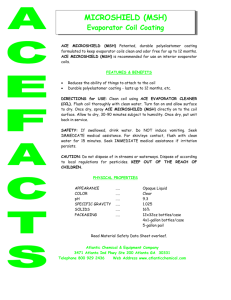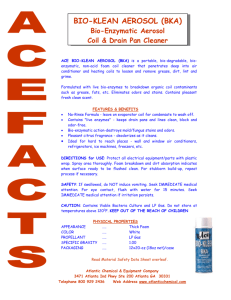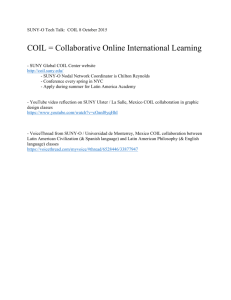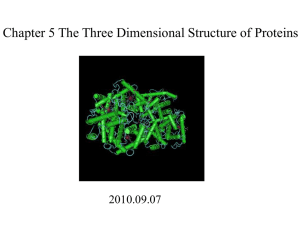Total Heat Versus Sensible Heat Evaporator Selection Methods
advertisement
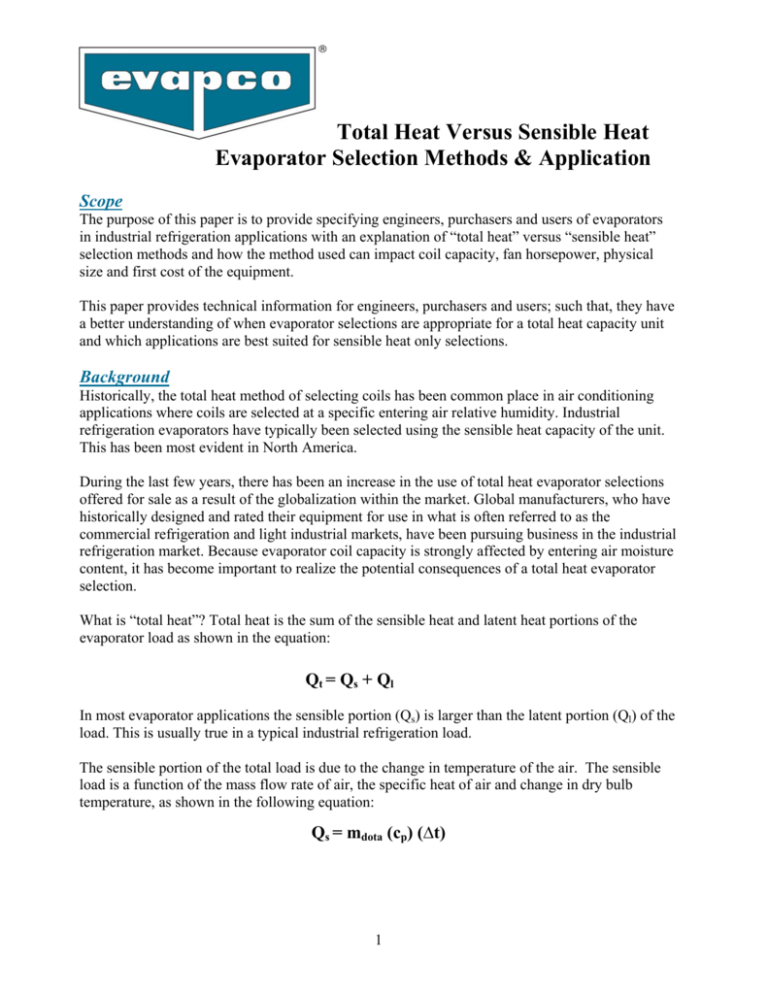
Total Heat Versus Sensible Heat Evaporator Selection Methods & Application Scope The purpose of this paper is to provide specifying engineers, purchasers and users of evaporators in industrial refrigeration applications with an explanation of “total heat” versus “sensible heat” selection methods and how the method used can impact coil capacity, fan horsepower, physical size and first cost of the equipment. This paper provides technical information for engineers, purchasers and users; such that, they have a better understanding of when evaporator selections are appropriate for a total heat capacity unit and which applications are best suited for sensible heat only selections. Background Historically, the total heat method of selecting coils has been common place in air conditioning applications where coils are selected at a specific entering air relative humidity. Industrial refrigeration evaporators have typically been selected using the sensible heat capacity of the unit. This has been most evident in North America. During the last few years, there has been an increase in the use of total heat evaporator selections offered for sale as a result of the globalization within the market. Global manufacturers, who have historically designed and rated their equipment for use in what is often referred to as the commercial refrigeration and light industrial markets, have been pursuing business in the industrial refrigeration market. Because evaporator coil capacity is strongly affected by entering air moisture content, it has become important to realize the potential consequences of a total heat evaporator selection. What is “total heat”? Total heat is the sum of the sensible heat and latent heat portions of the evaporator load as shown in the equation: Qt = Qs + Ql In most evaporator applications the sensible portion (Qs) is larger than the latent portion (Ql) of the load. This is usually true in a typical industrial refrigeration load. The sensible portion of the total load is due to the change in temperature of the air. The sensible load is a function of the mass flow rate of air, the specific heat of air and change in dry bulb temperature, as shown in the following equation: Qs = mdota (cp) (∆t) 1 Figure 1 below shows the sensible cooling load as a horizontal line starting at the entering air temperature and ending at the leaving air temperature. By definition, in a sensible heat only process there is no change in the moisture content of the air. Figure 1 - Sensible Load Only A latent cooling load occurs when water vapor is condensed, resulting in a change in the moisture content or relative humidity of the air. The latent load is calculated by multiplying the air mass flow rate by the water vapor heat of condensation and the change in water vapor content, as shown in the equation below: Ql = mdota (hfg) (∆w) Note: Water vapor has a heat of condensation of approximately 1,000 Btu/lb. The latent load is easily seen when using a psychometric chart and plotting the change in moisture content using the humidity ratio scale as shown in Figure 2. The latent load is a vertical line on the chart. There is no change in dry bulb temperature. The humidity ratio is expressed as pounds of water per pound of dry air. 2 Figure 2 - Latent Load Only Note: The following text and Figure 3 were taken from Industrial Refrigeration Handbook, Wilbert F Stoecker, Copyright 1998 (updated edition of Industrial Refrigeration, copyright 1988-1995). McGraw-Hill, pages 207 & 208. “Figure 3 below shows the sensible and latent heat removal in a coil. The total heat is the sum of both, with the sensible heat being that portion associated with a drop in dry-bulb temperature. The latent heat removal occurs because of the condensation of the water vapor. When the air conditions and coil temperature are such that moisture condenses, the latent heat becomes an additional capacity for the coil.” Figure 3 - Sensible and Latent Heat Removal in a Coil The total heat load of a coil is quantified based on the change in both temperature and humidity level as air passes through the cooling coil as shown in Figure 4. Each of the points shown represents the air property as it enters a respective row of the coil – in this case a twelve (12) row deep coil. The change in air property is shown starting at point #1 and moving in a downward orientation from right to left. The change in air property is not linear, as shown by the curved line. 3 45 2 1 50 3 4 15 406 5 7 45 8 12 10 11 35 9 40 35 10 30 30 35 40 Chart by: HANDS DOWN SOFTWARE, www.handsdownsoftware.com 45 50 DRY BULB TEMPERATURE - °F 55 .008 50 .007 45 .006 40 .005 35 .004 30 .003 25 DEW POINT TEMPERATURE - °F 20 50 HUMIDITY RATIO - POUNDS MOISTURE PER POUND DRY AIR .009 20 .002 10 .001 0 60 Figure 4 - Total Heat – 12 Row Deep Coil Cooling Curve Measuring Total Heat Capacity With this basic understanding of “total heat”, we will now discuss how “total heat” capacity is measured. There are several methods which can be used in a controlled laboratory environment to measure the total heat capacity of an evaporator coil. This paper will review two of these methods. The first method (Method #1) requires the entering air enthalpy, the leaving air enthalpy and the air flow. In order to determine air enthalpy both the air dry bulb and wet bulb temperatures must be measured. From these temperature measurements, air enthalpy can either be found on a psychometric chart or by using known equations. The air volume flow is measured and converted to mass flow rate. This process requires adjusting the air density as it will vary with temperature and humidity. Once these values are determined, the evaporator total heat capacity can be calculated using the following equation: Qt = mdota (∆hair) Using Method #1 poses a few challenges when measuring evaporator total heat capacity. The first challenge is accurately measuring wet bulb temperature below freezing. Wet bulb temperature is a widely accepted input used to determine moisture content in air or the air relative humidity. An accurate temperature sensor is covered with a water saturated cotton wick. The air passes over the wet cotton wick which causes the temperature measurement to depress below the dry bulb reading. As a result of this method, accurate wet bulb temperatures below the freezing point of water are more difficult to obtain and equally difficult to repeat. 4 The second challenge is measuring air flow rate on a free delivery evaporator. In most applications, the evaporator discharges air directly into the room or space without external ductwork. In order to accurately measure air flow rate it is usually necessary to add a duct or plenum on the evaporator to channel the air flow stream. Hence, the action of measuring the air flow can affect the air flow rate, which affects the evaporator capacity. The “channeling” of the air through a duct or plenum section for accurate air measurement may impact how the air returns to the coil which will result in a calculated performance which is different than that of the coil when used in its standard configuration. A solution to the challenges associated with using Method #1 to measure total heat evaporator capacity is contained in ARI (Air-Conditioning and Refrigeration Institute), now referred to AHRI (Air-Conditioning, Heating and Refrigeration Institute) STD 420, “Performance Rating of ForcedCirculation Free-Delivery Unit Coolers for Refrigeration”. As is the case with all AHRI standards, STD 420 was developed for laboratory analysis of equipment performance. This latest version of the standard was published in 2008 after five years of extensive revisions, including a comprehensive methodology on testing both direct expansion and liquid over-feed evaporators. The method of measuring total heat capacity per STD 420 commences with controlling and measuring the entering air temperature and relative humidity. In an environmentally controlled test laboratory, the entering air condition can be maintained at very precise conditions during the testing process. In addition, if the lab is maintained at a temperature above freezing, the wet bulb measurement is very straightforward. If the temperatures are below freezing there are other laboratory techniques that can be use to determine relative humidity. With this standard, the refrigerant flow rate and the entering and leaving refrigerant enthalpy are determined instead of measuring the leaving air condition and air flow rate. To achieve these measurements accurately, special instrumentation and laboratory setup are required. This is especially true for liquid overfeed evaporators. Refer to STD 420 for details on how to setup and measure liquid over feed evaporator capacity. The refrigerant side evaporator load calculation is straightforward when the various inputs have been determined using the equation: Qt = mdotr (∆ href) For liquid overfeed evaporators, the change in refrigerant enthalpy is determined using a secondary heat exchanger, not the evaporator which is under test. This allows for accurate determination of refrigerant side enthalpy change. Again, the details of the laboratory setup can be found in STD 420. This document can be downloaded at no cost from the Air-Conditioning Heating and Refrigeration Institute (AHRI). 5 Using Method #2, STD 420, offers several advantages. The entering air conditions are easier to measure, especially when the temperature is above freezing. Another advantage is airflow measurement is not required. This means the air discharging from the evaporator and the air returning to the evaporator are not affected by the process of measuring air flow. In addition, this method has been proven to be very accurate and repeatable. Lastly, this method can be used when the air flow rate is not constant which happens during evaporator capacity testing due to frost accumulation. When to Use a Total Heat Selection There are two necessary parameters for a proper total heat capacity evaporator selection: · Air inlet conditions are defined · Fin surface temperatures are above freezing (no frost accumulation) Both of these parameters must be defined in the project specification. Air inlet conditions include temperature and humidity. Fin surface temperatures must be high enough to prevent the coil from accumulating frost. This means the average coil fin temperature is above freezing. The importance of no frost will be discussed later in this paper. A review of the standard test conditions outlined in ARI STD 420 will provide clarification. Table 1, “ARI STD 420 Standard Test Conditions”, contains the five test conditions contained for coil performance tests. ARI STD 420 Standard Test Conditions Condition number Coil condition Dry-bulb Temperature Wet-bulb temperature Relative humidity Dew Point temperature Refrigerant Saturation Temperature Temperature Difference F F % F F F 1 Wet 50 46.1 75 - 35 15 2 Dry 50 - <45 <30 35 15 3 Dry 35 - <50 <20 25 10 4 Dry 10 - <46 <-5 0 10 <-25 -20 10 Specialists in Heat Transfer Transfer Products Products and and Services Services 5 Dry -10 - <43 Table 1 - Standard Test Conditions (ARI STD 420) 6 For this paper we are only discussing the first two sets of conditions. Condition #1 in the table provides the test parameters for a “wet coil” with the evaporator cooling and dehumidifying. This is a “total heat” condition. The total heat test conditions have been circled in the table. Notice the dry bulb and wet bulb temperatures specified for Condition #1 are 50 oF DB and 46.1 oF WB. In addition, notice the refrigerant saturation temperature or evaporating temperature has been specified as 35 oF. Condition #2 contains test parameters for a coil test using the same air temperature but with the dew point of the air below the coil saturation temperature. By definition, this is “dry air”. The dry entering air condition is achieved by separate dehumidification until the air dew point (< 30 oF) is at least 5 oF degrees below the evaporating temperature (35 oF). Table 2 below shows the impact of relative humidity (% RH) on coil capacity. Shown in the table is data from both the actual evaporator coil performance test results based on STD 420 test points and the calculated performance at the same conditions. The important numbers to review are the capacity ratio between the total heat coil condition and the dry coil condition which shows the difference between the total heat and dry rating of the same coil. The ratio is shown using both the actual test point and the calculated performance. Impact of % RH on Coil Capacity Dry-bulb Test Test Ratio Calculated RH Temperature Capacity Capacity Condition Coil Total Heat to number Conditions o F % Tons Tons Dry 1 2 Wet Dry 50 50 75 - 22.6 19.7 1.15 23.0 20.2 Calculated Ratio Total Heat to Dry 1.14 Table 2 - STD 420 Total Heat Laboratory Results The calculated ratio total heat and dry capacity is 1.14 versus the test ratio of 1.15. This demonstrates the magnitude of the capacity ratio using these wet and dry coil conditions and the accuracy of the calculated ratio when compared to the laboratory test. It should be noted that the total heat to dry capacity ratio is not simply the inverse of the sensible heat ratio for the coil operating at the wet condition. (Sensible heat ratio is the ratio of the sensible portion of the load to the total load.) This is because the “dry” coil capacity is larger than the sensible portion of a total heat capacity. The difference becomes greater as the latent percentage increases. In Tables 3 and 4 are two examples showing the effect relative humidity (RH) has on the selection of an evaporator. These selections were made with the Evapco iES Electronic Selection Software. 7 Selection Criteria: RH 65% 85% 95% Effect of % RH on Evaporator Selection Capacity: 20 TR Room Temperature: 50oF Evaporating Temperature: 38oF Temperature Difference (TD): 12oF MODEL SSTM3-01819-4 SSTM3-01738-4 SSTM2-01367-4 TR 20.7 20.5 20.4 # OF FANS 3 3 2 MOTOR HP 0.75 0.75 1 TOTAL HP 2.25 2.25 2 RELATIVE PRICE 100% 91% 75% COIL VOLUME 3.44 3.09 2.61 Table 3 – 20 TR Evaporator Selection at varying Relative Humidity Selection Criteria: RH 65% 85% 95% Effect of % RH on Evaporator Selection Capacity: 50 TR Room Temperature: 65oF Evaporating Temperature: 45oF Temperature Difference (TD): 20oF MODEL SSTM4-02631.4 SSTM3-01975-4 SSTM3-01738-4 TR 50 51.8 51.6 # OF FANS 4 3 3 MOTOR HP 0.75 0.75 0.75 TOTAL HP 3 2.25 2.25 RELATIVE PRICE 100% 78% 69% COIL VOLUME 5.13 3.87 3.09 Table 4 – 50 TR Evaporator Selection at varying Relative Humidity The ratio of total heat capacity to dry capacity is dependent on the coil geometry. The ratio will change with rows deep, fin material, and tube pattern. Temp Difference, F When coil conditions result in a frosted coil, there can be a problem with the use of a total heat selection method. The major reason for this is that the coil does not achieve the steady state performance predicted in a total heat calculation. Figure 5 below shows the dividing line between a frosted coil performance and a wet coil performance or when fin surface temperature will be below freezing. 25 20 Wet Frosted 15 10 5 0 14 18 22 26 30 Evaporating Temp, F Figure 5 - Wet-Frost Boundary 8 34 There are three design / test points shown on Figure 6 that demonstrate some of the problems with a total heat selection in the frosted area. Temp Difference, F 25 20 Wet 3 Frosted 15 2 1 10 5 0 14 18 22 26 30 34 Evaporating Temp, F Figure 6 - Wet-Frost Boundary with Test Points At the first test point, the conditions are 30 oF room, 84% RH inlet air and a 10 oF TD. The calculated and actual test performance for a coil at these conditions is shown in Figure 7 below. The green line shows the calculated coil capacity ratio wet to dry for the inlet conditions. To run this test, the Evapco low temperature lab is started “dry”, with the entering air dew point below suction temperature. A special instrument called a chilled mirror hygrometer is used to measure the air dew point. After room conditions have stabilized and the dry evaporator capacity is known, a humidifier is turned on to quickly raise the entering air humidity to the target level. Coil capacity is then recorded over time as frost accumulates on the coil. Note how the peak coil capacity ratio falls short of the calculated ratio. 1.20 Test Coil ABC Room temp 30F; 84% RH 1.15 Capacity Ratio, Frosted/Dry 10F TD Calculated ratio 1.10 1 1.05 1.00 Humidifier ON 0.95 0.90 0 1 2 3 4 5 6 7 8 9 10 Time [hr] Figure 7 - Frost Accumulation 20oF Suction 9 11 12 Figure 8 shows a different coil at two progressively higher temperature differences (TD’s) and higher relative humidity percentages (% RH). These are Points 2 and 3 on Figure 6. Note the similar shaped curves and the decline in evaporator capacity over time. The expected total heat capacity ratio is about 1.35, well above the tested peak capacity ratios. Note also, the impact of raising the coil TD was just a shortened run time until defrost. Test Coil XYZ 32oF Room Temp; 95% RH @18o TD, Qdry = 40 Tons @12o TD, Qdry = 27 Tons Capacity Ratio (Qfrosted/Qdry 1.2 1.15 1.1 2 1.05 1 o 18 F TD 12oF TD 0.95 3 0.9 0.85 0 1 2 3 4 5 Time [hr] Figure 8 – Evaporator Performance at 20oF and 14oF Evaporating Temperatures At lower room temperatures, relative humidity has less of an impact on coil capacity. At high relative humidity and lower temperatures, the pounds of water per pound of dry air is a small fraction of the water content available at warmer temperatures Figure 9 shows the performance of a third coil at lower room temperatures. The actual ratio of wet to dry performance is less than 1.05 at the peak conditions. Over time this performance decreases and is always below the predicted calculated total heat capacity. Calculated Calculated Ratio Ratio 1.1 1.1 Coil CoilEFG EFG Ro Room omTemp Temp-10 -10FF;; 95% 95%RH RH Capacity Ratio, Ratio, Frosted/Dry Frosted/Dry Capacity 1. 1.05 05 10 10 FFTD TD 11 0. 0.95 95 Humidifier Humidifier ON ON 0.9 0.9 0. 0.85 85 0.8 0.8 00 22 44 66 88 10 10 12 12 14 14 16 16 18 18 20 20 22 22 Time Time [hr] [hr] Figure 9 – Evaporator Performance in a -10 oF Freezer at 95%RH 10 In a -10 oF freezer, when the entering air relative humidity is increased to over 95% RH, the evaporator capacity increases only slightly. The evaporator performance though drops off more rapidly as frost accumulates to block airflow and insulate the fin surface. This is shown in Figure 10. Calculated Ratio 1.1 Coil EFG Room Temp -10 F; 95 to 100% RH Capacity Ratio, Frosted/Dry 1.05 10F TD 1 0.95 Humidifier ON 0.9 0.85 0.8 0 2 4 6 8 10 12 14 16 18 20 22 Time [hr] Figure 10 – Evaporator Performance in a -10 oF Freezer at RH>95% Summary Total heat selections should be used when the air inlet conditions are known and specified. This will ensure the evaporator selected will have the capability to provide the necessary cooling when taking into account the latent capacity requirement. Conversely, using a total heat selection based on an entering air with a relative humidity percentage greater than the actual relative humidity will result in a coil selection with a cooling capacity less than specified for the application. If you use a manufacturer’s evaporator selection program, which automatically makes total heat selections, you must make sure the “default” entering air relative humidity value is equal to or less than the known room condition. If you do not know the room air condition it is recommended that you select the coil at 40% RH (sensible heat selection) to ensure you select coils with sufficient cooling capacity. In addition to knowing the entering air conditions, total heat selections should be used when the fin surface temperature is above freezing resulting in a wet coil condition. Typical applications where this will be acceptable are process rooms using outside air and having humid return air conditions. Examples are meat processing rooms, cutting rooms and slicing rooms. Importantly, it is not good engineering practice to use a total heat evaporator selection when the air inlet conditions are assumed “humid” when sizing an evaporator for a low temperature room. The evaporator will be smaller resulting in a faster frost accumulation and shorter run times regardless of the actual room relative humidity. 11 Recommendations EVAPCO recommends using total heat evaporator selections when the entering air conditions are specified at suction temperatures which are unlikely to allow frost to accumulate. This is best demonstrated by the graph shown in Figure 11. The graph shows the relationship between the air to refrigerant temperature difference (degree F) and evaporator temperature (degree F). Temp Difference, F 25 20 15 10 5 0 14 18 22 26 30 34 Evaporating Temp, F Figure 11 - Wet Coil versus Frosted Coil Boundary The curve shown is the recommended “boundary” line which determines whether a coil will operate “frosted” or “wet” which would determine the selection method. As shown, it is acceptable to use a total heat selection for coils which will operate in the “wet” region to the right of the curve, provided the entering air relative humidity is known. For example, for an evaporator being sized for a room with 85% RH with an evaporating temperature of 30oF and a temperature difference of 10oF, Evapco recommends selecting the evaporator coil based on a total heat basis. Based on the curve shown in Figure 11, this coil will operate “wet”. In addition, the relative humidity of the air is known. If the evaporator was specified to operate at a 25oF evaporating temperature and a 10oF air to refrigerant temperature difference the coil capacity should not be based on total heat. The predicted total heat capacity for this application will be higher then the coil can produce at these conditions and the coil will build frost faster since it is smaller than correct recommended selection for the application. Please contact your local EVAPCO Representative or the Industrial Refrigeration Marketing Department at our World Headquarters & Research Center located in Maryland for more information on this subject, for product selections or to schedule a personal tour of the Research Center. Contact Information EVAPCO, Inc. 5151 Allendale Lane Taneytown, Maryland 21787 Telephone: (410) 756-2600 Facsimile: E-mail: Website: 12 (410) 756-6450 marketing@evapco.com www.evapco.com
